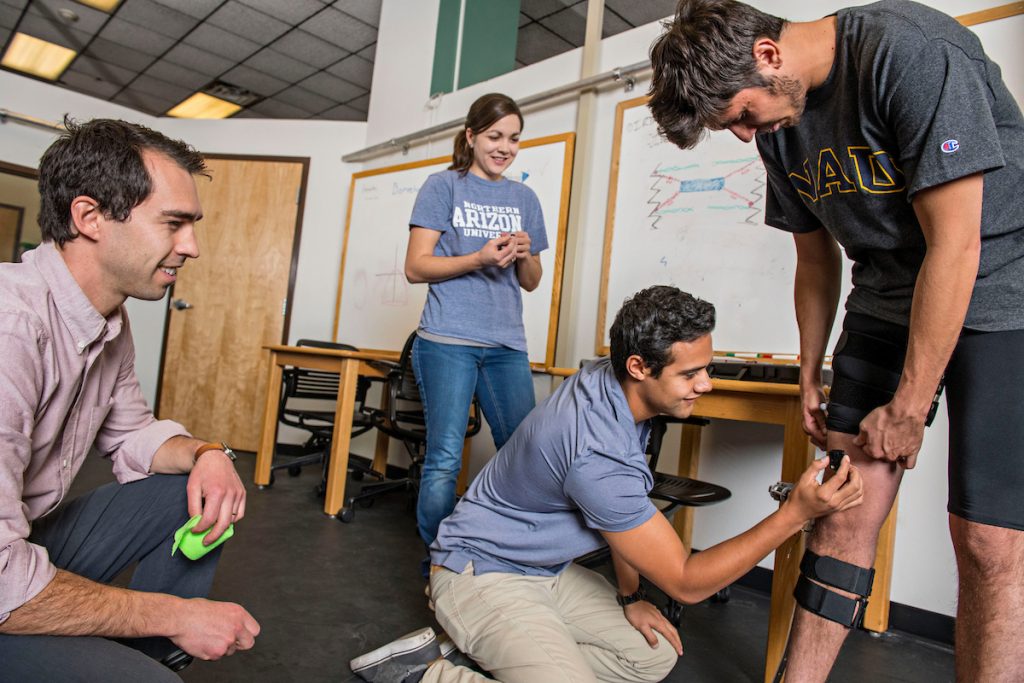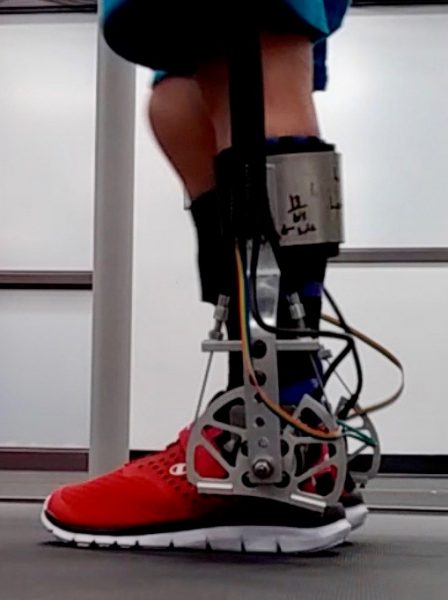Feb. 19, 2019
Nearly four in 1,000 children are afflicted with cerebral palsy (CP), making it the most common cause of pediatric physical disability in the United States. This neurological disorder, typically caused by damage to the brain before birth, affects a child’s muscle control and coordination and often makes walking extremely difficult. What’s more, children with CP in Arizona, in both rural and urban areas, lack access to the basic treatment needed to prevent this ambulatory decline, which worsens as they grow older.
Although CP cannot be cured, treatments can improve the overall quality of life for affected patients. One of the most promising potential new treatment options is the use of battery-powered wearable devices, or exoskeletons, that could provide home-based gait training and mobility assistance that is not limited by the patient’s proximity to urban research facilities.
Zach Lerner, assistant professor of mechanical engineering and faculty in Northern Arizona University’s Center for Bioengineering Innovation, has been focusing his research for several years on developing improved exoskeletons, which could significantly decrease CP patients’ lifelong suffering and the resulting economic burdens placed on their families. Lerner, who leads a team of researchers working in NAU’s Biomechatronics Lab, has been awarded a total of $600,000 over the past several months through grants from the National Institutes of Health (NIH), the National Science Foundation (NSF) and the Arizona Biomedical Research Commission (ABRC) to continue this work.
“By improving coordinated muscle control, fatigue resistance and walking economy, evidence suggests that children with CP wearing these devices may engage in greater amounts of habitual physical activity,” Lerner said. “This would likely prolong walking ability and have many additional physical and mental health benefits, such as increasing muscle and bone mass. Increased daily activity would likely also have rehabilitation-related benefits, including maintenance or improvement of underlying walking ability, by increasing muscle strength and coordination.”
All three grants are focused on research improving how wearable exoskeletons can improve walking ability in individuals with movement disorders.
- The NIH granted Lerner an Early Career Research Award for $284,000 for a two-year project, “Pediatric Gait Rehabilitation via Wearable Robotic Assistance.”
- The ABRC granted Lerner a $225,000 New Investigator Award for a three-year research project that will improve the health of Arizona’s children. A unit of the Arizona Department of Health Services, ABRC’s mission is to advance Arizona as a biosciences leader and provide funding to accelerate promising health research.
- The NSF granted Lerner a Research Initiation Award for $175,000 for a two-year project, “CRII: SCH: A Framework for Optimizing Exoskeleton-Assisted
Walking Performance in Children with Cerebral Palsy.”
“The overarching goal of our research is to improve the ability of children with gait disorders to walk independently and accumulate adequate levels of daily physical activity,” he said. “To meet this goal, we’re evaluating the benefits of powered lower-extremity assistance on rehabilitation and mobility-related outcomes. Our central hypothesis is that repeated walking with powered knee and ankle assistance will help re-train the neuromuscular system to achieve a more efficient gait pattern, and that battery-powered exoskeleton assistance can improve walking performance in real-world settings.”
Team to use labs at NAU’s Flagstaff campus and Phoenix Biomedical Campus
Lerner and his team will use several different facilities on NAU’s Flagstaff campus—including the Biomechatronics Lab and the Human Performance Lab—as well as at the university’s Phoenix Biomedical Campus (PBC) to perform their research. In addition to providing multisite data collection capabilities for study participants across the state of Arizona, PBC is near Phoenix Children’s Hospital, which specializes in the treatment of CP.
Lerner and his team also authored a paper published in October in IEEE Transactions on Neural Systems and Rehabilitation Engineering, which describes a project to develop an untethered ankle exoskeleton with the ability to reduce the metabolic cost of walking in children and young adults with gait pathology from CP. This is the first study to demonstrate that battery-powered exoskeleton assistance can measurably improve walking efficiency in individuals with neuromuscular deficits. His NAU collaborators on the project were engineers from the Lerner Biomechatronics Lab, including Gian Maria Gasparri, Michael Bair, Jenny Lawson, Jason Luque and Taryn Harvey, and Andrea Lerner from the Department of Physical Therapy.
Lerner’s work was featured in the video “Helping Kids Walk with Wearable Robots” on the “Superhuman” show by Freethink, which has attracted more than 830,000 views worldwide.
People interested in participating can contact Zach Lerner: Zachary.Lerner@nau.edu or (928) 523-1787.

(928) 523-5556 | kerry.bennett@nau.edu




